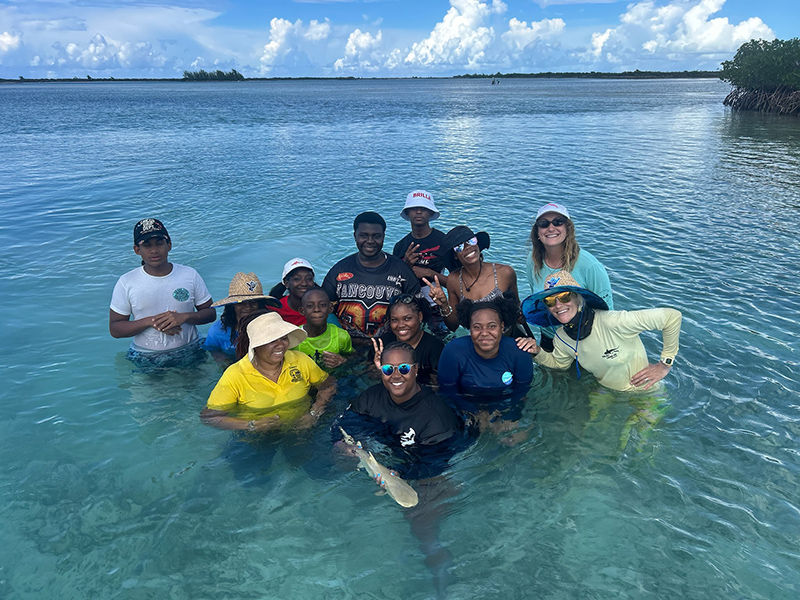January Elasmobranch of the Month: The Nurse Shark
- Sharks4Kids

- Jan 24, 2024
- 3 min read
Nurse Shark
Ginglymostoma cirratum
Key Features & Appearance
In the darkness of the ocean, it isn’t always easy to find a good meal. Luckily for nurse sharks, they are equipped with nasal barbels, which protrude from their face like fangs! This unique feature is shared by other species of sharks, as well as several fish species, such as catfish.
Nurse sharks are yellow-brown, with small eyes and thousands of saw-like teeth. On average, they grow from about 7.5 to 8 feet long, although they have been even recorded at lengths of up to 14 feet! Though these sharks may seem a bit frightening, they are extremely docile around humans. They are not only nocturnal but are also particularly slow swimmers; you’re not likely to run into an active nurse shark during the day.

Habitat & Distribution
Like many people, nurse sharks prefer the shallow waters of temperate regions. You can find them in the eastern and western Atlantic Ocean, as well as the eastern Pacific Ocean. These sharks are bottom dwellers, meaning that they spend much of their time near the seafloor. Nurse sharks are usually found at an average of 16 to 98 feet; however, they can venture as far as 230 feet deep!
During the day, nurse sharks can be found in crevices and caves, where they sleep in groups of up to 40 members. These spots make for a great resting place as they wait for night to fall and for their hunting to begin. It has even been observed that nurse sharks return to the same spots time and time again, rather than constantly finding new places to rest.
Diet
With their prey being active during the day, nurse sharks are too slow to keep up. Instead, they opt to hunt by night. Using their nasal barbels, they can sense their prey throughout the dark ocean. Yet, even though nurse sharks have an advantage at night, they still target slow-moving fish, such as lizardfish. They also feed on coral, shellfish, and shrimp, with their favorite food being squid.
Reproduction
The nurse shark’s gestation period lasts from about 4.5 to 6 months. As an ovoviparous species, their eggs hatch while they are still inside the female shark’s body; therefore, she still technically gives live birth.
Nurse shark pups are typically born in the late spring or early summer. Litter sizes range anywhere from 20 to 40 pups at a time. Once born, these pups are left to fend for themselves. Like every other shark species, nurse sharks have never been recorded showing parental care to their young post-birth.

Threats
Life as a smaller shark species can be daunting—larger sharks know how to make a quick meal out of them. Nurse sharks have been known to be targeted by other species, such as bull, lemon, tiger, and great hammerhead sharks.
Moreover, their affinity for shallow waters can be risky, as they often stray near humans. Luckily, divers tend to be fond of feeding nurse sharks, which has become a popular ecotourism activity. In comparison to other shark species, the nurse shark’s docile nature makes them incredibly approachable. However, it is always important to respect sharks and their home, no matter how comfortable they may be around humans.
Unfortunately, nurse sharks are often the victims of the fishing industry’s bycatch, just like countless other shark species. Certain areas of the world also hunt them for their meat, fins, and skin, such as Panama, Venezuela, Brazil, and the Caribbean.

Image credit: Jillian Morris
Status
According to the International Union for Conservation of Nature (IUCN), nurse sharks are listed as “data deficient.” In other words, there is not enough data to determine their conservation status.
Nevertheless, nurse sharks are generally considered to be an abundant species of shark. Yet, certain populations have witnessed a decrease in numbers, specifically in Florida and the Eastern Pacific Ocean. In the south of Brazil, they are locally extinct.
Fun Fact
Did you know that nurse sharks have been trained to respond to sound? During the 1950s and 60s, both lemon and Atlantic nurse sharks underwent training to test their learning capacity. The study demonstrated that the sharks not only responded to the sound but still remembered their instructions months later. The US Navy performed a similar experiment, in which trainers threw a ring into a pool and trained the sharks to bring it back—like a dog playing fetch!
Works Cited
Castro, José I. “The Biology of the Nurse Shark, Ginglymostoma Cirratum, off the Florida East Coast and the Bahama Islands - Environmental Biology of Fishes.” SpringerLink, Kluwer Academic Publishers, link.springer.com/article/10.1023/A:1007698017645.
“Ginglymostoma Cirratum.” Discover Fishes, www.floridamuseum.ufl.edu/discover-fish/species-profiles/ginglymostoma-cirratum/.
“Nurse Shark - Ginglymostoma Cirratum.” Shark Research Institute, www.sharks.org/nurse-shark-ginglymostoma-cirratum.
“Nurse Shark.” Encyclopædia Britannica, Encyclopædia Britannica, inc., www.britannica.com/animal/nurse-shark-family.
“Nurse Shark.” Oceana, 26 June 2023, oceana.org/marine-life/nurse-shark/.
“Nurse Shark: National Geographic.” Animals, www.nationalgeographic.com/animals/fish/facts/nurse-shark.





















